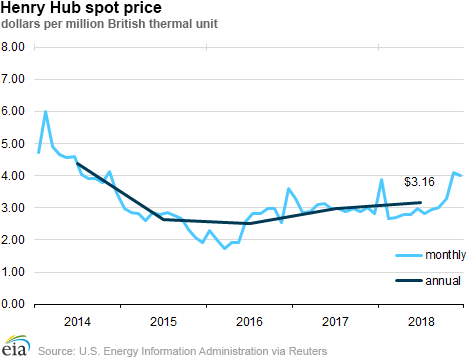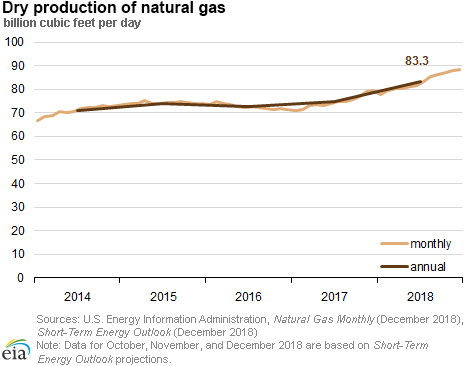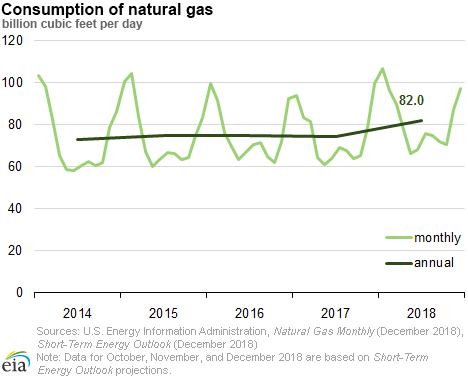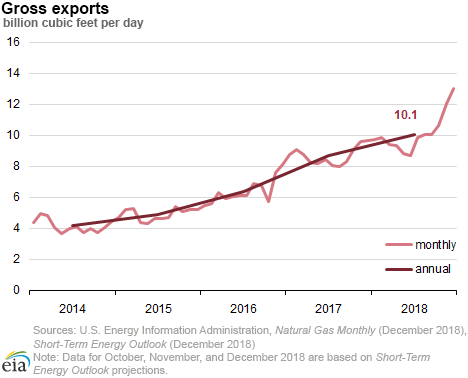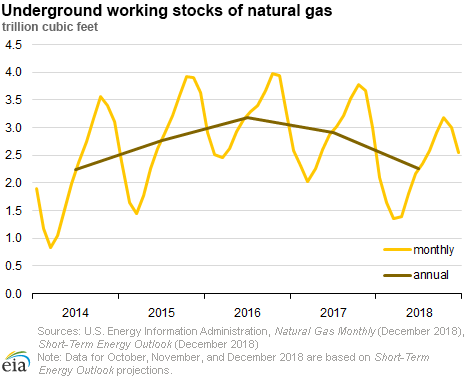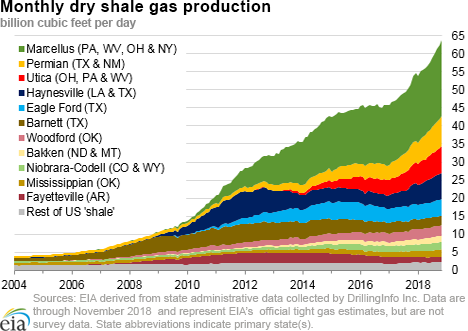In the News:
Top natural gas stories of 2018 focus on record production, consumption, and exports
Natural gas production in the United States reached record levels in 2018. Natural gas production grew consistently throughout the year, led by production increases in the Appalachian Basin, the Permian Basin, and the Haynesville shale formation. Production growth was driven by different factors depending on the region, including increased takeaway capacity, more efficient drilling, higher crude oil production, and elevated natural gas prices.
Natural gas consumption in the United States reached record levels in 2018. Natural gas consumption growth was driven primarily by increases in the electric power sector, with the generation mix showing natural gas and renewables displacing coal-fired generation during the year. Natural gas consumption also increased in the industrial, residential, and commercial sectors in 2018, although residential and commercial sector consumption increases were the result of unusually cold weather in the first quarter of 2018, in particular in early January 2018.
Natural gas storage stocks reached extremely low levels in 2018. Natural gas storage inventories ended the heating season on March 31 at their lowest level since 2014, and they did not refill during the summer injection season as quickly as in previous years. Low volumes of natural gas injected into storage were the result of growing levels of natural gas exports and high consumption. Natural gas storage inventories entered the winter season on November 1 at significantly lower levels than in previous years, which contributed to unusual price volatility and price increases in later months of the year.
Natural gas exports reached new highs in 2018. Natural gas exports reached record levels in 2018, driven primarily by exports of liquefied natural gas (LNG), and secondarily by pipeline exports to Mexico. LNG export capacity is expected to continue growing in 2019 as new LNG export facilities enter service.
Overview:
(For the Week Ending Wednesday, January 9, 2019)
- Natural gas spot prices rose at most locations this report week (Wednesday, January 2 to Wednesday, January 9). Henry Hub spot prices rose from $2.79 per million British thermal units (MMBtu) last Wednesday to $2.91/MMBtu yesterday.
- At the Nymex, the price of the February 2019 contract increased 3¢, from $2.958/MMBtu last Wednesday to $2.984/MMBtu yesterday. The price of the 12-month strip averaging February 2019 through January 2020 futures contracts climbed 10¢/MMBtu to $2.844/MMBtu.
- Net withdrawals from working gas totaled 91 billion cubic feet (Bcf) for the week ending January 4. Working natural gas stocks are 2,614 Bcf, which is 7% lower than the year-ago level and 15% lower than the five-year (2014–18) average for this week.
- The natural gas plant liquids composite price at Mont Belvieu, Texas, rose by 11¢/MMBtu, averaging $6.21/MMBtu for the week ending January 9. The price of propane fell by 1%. The price of natural gasoline, butane, isobutane, and ethane rose by 10%, 3%, 2%, and 1% respectively.
- According to Baker Hughes, for the week ending Tuesday, January 1, the natural gas rig count remained flat at 198. The number of oil-directed rigs fell by 8 to 877. The total rig count decreased by 8, and it now stands at 1,075.
Prices/Supply/Demand:
Prices rise across most of the Lower 48 states. This report week (Wednesday, January 2 to Wednesday, January 9), Henry Hub spot prices rose 12¢ from $2.79/MMBtu last Wednesday to their weekly high of $2.91/MMBtu yesterday. At the Chicago Citygate, prices increased 6¢ from $2.64/MMBtu last Wednesday to $2.70/MMBtu yesterday. Temperatures this report week were warmer than normal across the Lower 48 states, and much warmer than normal across the Midwest, especially in the Great Plains. However, forecasts for snow and the return of winter weather on the East Coast put upward pressure on prices at the end of this report week.
Northeast prices rise. Prices in the Northeast nearly doubled during the report week with the anticipation of cold weather. At the Algonquin Citygate, which serves Boston-area consumers and is pipeline constrained, prices went up $3.63 from $2.97/MMBtu last Wednesday to their weekly high of $6.60/MMBtu yesterday. At the Transcontinental Pipeline Zone 6 trading point for New York City, prices increased $2.53 from $2.72/MMBtu last Wednesday to their weekly high of $5.25/MMBtu yesterday.
Tennessee Zone 4 Marcellus spot prices increased 19¢ from $2.52/MMBtu last Wednesday to $2.71/MMBtu yesterday. Prices at Dominion South in southwest Pennsylvania rose 14¢ from $2.51/MMBtu last Wednesday to $2.65/MMBtu yesterday.
Prices fall in California. Prices at PG&E Citygate in Northern California fell 40¢, down from $3.82/MMBtu last Wednesday to $3.42/MMBtu yesterday. Prices at SoCal Citygate decreased $2.99 from $7.65/MMBtu last Wednesday to $4.66/MMBtu yesterday.
Discount at Permian Basin trading hub persists. Prices at the Waha Hub in West Texas, which is located near Permian Basin production activities, averaged $2.43/MMBtu last Wednesday, 36¢/MMBtu lower than Henry Hub prices. Thursday’s Waha/Henry Hub spread of 30¢/MMBtu was the narrowest discount since November 2018. However, prices declined during the week, and yesterday, prices at the Waha Hub averaged $2.06/MMBtu, 85¢/MMBtu lower than Henry Hub prices.
Supply rises. According to data from PointLogic Energy, the average total supply of natural gas rose by 1% compared with the previous report week. Dry natural gas production remained constant week over week. Average net imports from Canada increased by 18% from last week as U.S. imports from Canada increased while U.S. exports to Canada declined. According to Genscape data, flows at Waddington, New York, on the 1.25 Bcf/d capacity Iroquois pipeline, which brings natural gas from Canada down to the New York City area, rose more than 30% week to week. Flows at St. Clair, Michigan, on the 1.35 Bcf/d capacity Vector pipeline, which delivers natural gas into the Dawn hub in Ontario, Canada, declined by more than 20% from the previous report week, driving declines in U.S. exports into Canada.
Demand falls amid warm temperatures. Total U.S. consumption of natural gas fell by 3% compared with the previous report week, according to data from PointLogic Energy. Natural gas consumed for power generation declined by 1% week over week. Industrial sector consumption decreased by 2% week over week. In the residential and commercial sectors, consumption declined by 4%. Natural gas exports to Mexico increased 19%. U.S. exports to Mexico, which were low as a result of depressed holiday demand and higher production within Mexico, rebounded this week and reached a new daily high of 5.2 Bcf/d according to S&P Global Platts.
U.S. LNG exports are flat week over week. 10 LNG vessels (7 from the Sabine Pass liquefaction terminal, 2 from Cove Point, and 1 from Corpus Christi) with a combined LNG-carrying capacity of 36.2 Bcf departed the United States between January 3 and January 9. One vessel was loading at Sabine Pass on Wednesday, according to shipping data compiled by Bloomberg.
Cheniere Energy, the developer of the Sabine Pass and Corpus Christi liquefaction facilities, received a letter order last week from the Federal Energy Regulatory Commission granting it approval to introduce natural gas and commission the Train 2 fuel gas system at Corpus Christi. The commissioning of Train 2 is progressing several months ahead of the previously announced schedule. Train 1 at Corpus Christi facility has been placed in service and shipped its first LNG cargo on December 11, 2018. The third train at Corpus Christi is currently under construction, with an expected in-service date of May 2021.
U.S. LNG exports reach new record high. U.S. LNG exports in December 2018 set another record, with 36 exported cargoes, after Train 5 at Sabine Pass and Train 1 at Corpus Christi began producing LNG and shipped their first cargoes. Currently, seven liquefaction trains are operating in the United States across three facilities (five trains at Sabine Pass, one at Cove Point, and one at Corpus Christi). Three more liquefaction projects (Cameron LNG, Elba Island, and Freeport) are expected to enter service in 2019.
Storage:
Net withdrawals from storage totaled 91 Bcf for the week ending January 4, compared with the five-year (2014–18) average net withdrawals of 187 Bcf and last year's net withdrawals of 337 Bcf during the same week. Working gas stocks totaled 2,614 Bcf, which is 464 Bcf lower than the five-year average and 204 Bcf lower than last year at this time.
The average rate of net withdrawals from storage is 22% lower than the five-year average so far in the withdrawal season (November through March). If the rate of withdrawals from storage matched the five-year average of 16.8 Bcf/d for the remainder of the withdrawal season, total inventories would be 1,172 Bcf on March 31, which is 464 Bcf lower than the five-year average of 1,636 Bcf for that time of year.
More storage data and analysis can be found on the Natural Gas Storage Dashboard and the Weekly Natural Gas Storage Report.
See also:
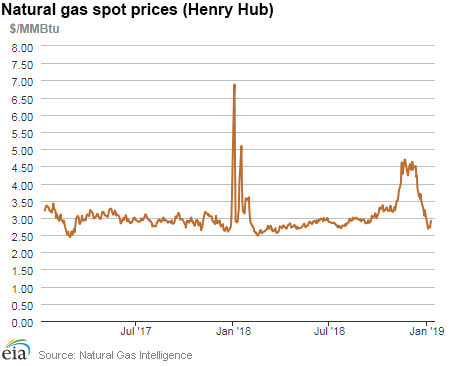
| Spot Prices ($/MMBtu) | Thu, 3-Jan |
Fri, 4-Jan |
Mon, 7-Jan |
Tue, 8-Jan |
Wed, 9-Jan |
|---|---|---|---|---|---|
| Henry Hub | 2.69 | 2.75 | 2.72 | 2.88 | 2.91 |
| New York | 2.54 | 2.56 | 2.66 | 3.12 | 5.25 |
| Chicago | 2.51 | 2.62 | 2.55 | 2.74 | 2.70 |
| Cal. Comp. Avg,* | 3.91 | 3.39 | 3.30 | 3.31 | 3.16 |
| Futures ($/MMBtu) | |||||
| February Contract | 2.945 | 3.044 | 2.944 | 2.967 | 2.984 |
| March Contract | 2.812 | 2.905 | 2.847 | 2.835 | 2.840 |
| *Avg. of NGI's reported prices for: Malin, PG&E Citygate, and Southern California Border Avg. | |||||
| Sources: Natural Gas Intelligence and CME Group as compiled by Bloomberg, L.P. | |||||
| Spot Prices ($/MMBtu) | Thu, 27-Dec |
Fri, 28-Dec |
Mon, 31-Dec |
Tue, 1-Jan |
Wed, 2-Jan |
|---|---|---|---|---|---|
| Henry Hub | 3.07 | 3.23 | Holiday | Holiday | 2.79 |
| New York | 2.94 | 3.15 | Holiday | Holiday | 2.72 |
| Chicago | 2.99 | 3.08 | Holiday | Holiday | 2.64 |
| Cal. Comp. Avg,* | 3.84 | 3.91 | Holiday | Holiday | 4.04 |
| Futures ($/MMBtu) | |||||
| January Contract | 3.642 | Expired | Expired | Expired | Expired |
| February Contract | 3.546 | 3.303 | 2.940 | Holiday | 2.958 |
| March Contract | 3.353 | 3.148 | 2.851 | Holiday | 2.829 |
| *Avg. of NGI's reported prices for: Malin, PG&E Citygate, and Southern California Border Avg. | |||||
| Sources: Natural Gas Intelligence and CME Group as compiled by Bloomberg, L.P. | |||||
| Spot Prices ($/MMBtu) | Thu, 20-Dec |
Fri, 21-Dec |
Mon, 24-Dec |
Tue, 25-Dec |
Wed, 26-Dec |
|---|---|---|---|---|---|
| Henry Hub | 3.70 | 3.53 | Holiday | Holiday | 3.22 |
| New York | 3.33 | 3.49 | Holiday | Holiday | 3.24 |
| Chicago | 3.45 | 3.25 | Holiday | Holiday | 2.96 |
| Cal. Comp. Avg,* | 4.10 | 3.77 | Holiday | Holiday | 3.97 |
| Futures ($/MMBtu) | |||||
| January Contract | 3.583 | 3.816 | 3.467 | Holiday | 3.543 |
| February Contract | 3.526 | 3.750 | 3.423 | Holiday | 3.458 |
| *Avg. of NGI's reported prices for: Malin, PG&E Citygate, and Southern California Border Avg. | |||||
| Sources: Natural Gas Intelligence and CME Group as compiled by Bloomberg, L.P. | |||||
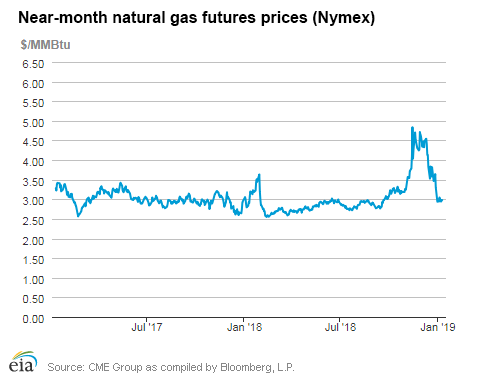
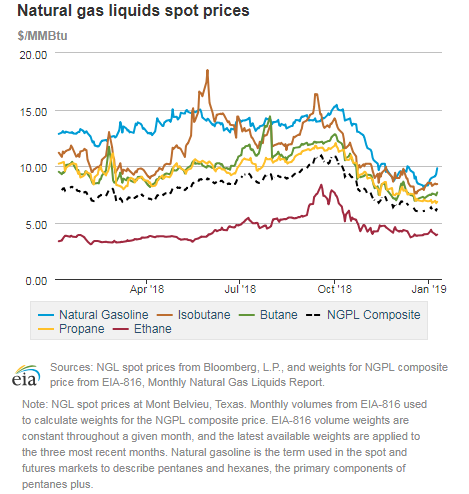
| U.S. natural gas supply - Gas Week: (1/3/19 - 1/9/19) | |||
|---|---|---|---|
Average daily values (Bcf/d): |
|||
this week |
last week |
last year |
|
| Marketed production | 97.7 |
97.9 |
83.4 |
| Dry production | 87.4 |
87.6 |
74.8 |
| Net Canada imports | 5.7 |
4.9 |
6.6 |
| LNG pipeline deliveries | 0.2 |
0.2 |
1.1 |
| Total supply | 93.4 |
92.7 |
82.5 |
|
Source: OPIS PointLogic Energy, an IHS Company | |||
| U.S. natural gas consumption - Gas Week: (1/3/19 - 1/9/19) | |||
|---|---|---|---|
Average daily values (Bcf/d): |
|||
this week |
last week |
last year |
|
| U.S. consumption | 82.6 |
84.9 |
120.6 |
| Power | 22.3 |
22.5 |
30.0 |
| Industrial | 23.9 |
24.4 |
26.2 |
| Residential/commercial | 36.4 |
38.0 |
64.4 |
| Mexico exports | 4.7 |
4.0 |
4.3 |
| Pipeline fuel use/losses | 6.5 |
7.1 |
9.4 |
| LNG pipeline receipts | 5.0 |
4.9 |
2.4 |
| Total demand | 98.9 |
100.9 |
136.7 |
|
Source: OPIS PointLogic Energy, an IHS Company | |||
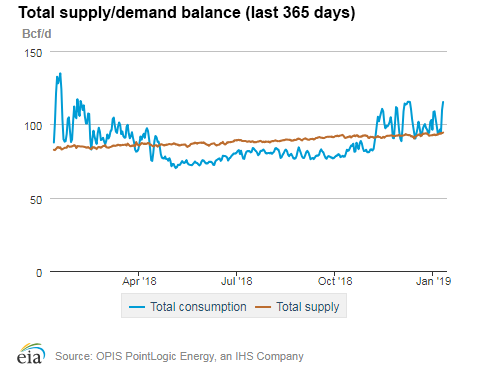
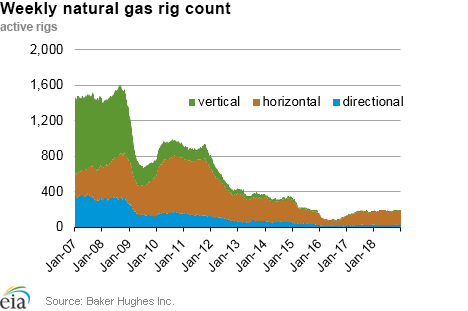
| Rigs | |||
|---|---|---|---|
Tue, January 01, 2019 |
Change from |
||
last week |
last year |
||
| Oil rigs | 877 |
-0.9% |
18.2% |
| Natural gas rigs | 198 |
0.0% |
8.8% |
| Note: Excludes any miscellaneous rigs | |||
| Rig numbers by type | |||
|---|---|---|---|
Tue, January 01, 2019 |
Change from |
||
last week |
last year |
||
| Vertical | 64 |
-5.9% |
3.2% |
| Horizontal | 945 |
0.0% |
18.4% |
| Directional | 66 |
-5.7% |
3.1% |
| Source: Baker Hughes Inc. | |||
| Working gas in underground storage | ||||
|---|---|---|---|---|
Stocks billion cubic feet (Bcf) |
||||
| Region | 2019-01-04 |
2018-12-28 |
change |
|
| East | 651 |
661 |
-10 |
|
| Midwest | 763 |
798 |
-35 |
|
| Mountain | 132 C |
147 |
-15 |
|
| Pacific | 204 |
220 |
-16 |
|
| South Central | 865 |
878 |
-13 |
|
| Total | 2,614 C |
2,705 |
-91 |
|
|
Source: Form EIA-912, "Weekly Underground Natural Gas Storage Report" C=Reclassification | ||||
| Working gas in underground storage | |||||
|---|---|---|---|---|---|
Historical comparisons |
|||||
Year ago (1/4/18) |
5-year average (2014-2018) |
||||
| Region | Stocks (Bcf) |
% change |
Stocks (Bcf) |
% change |
|
| East | 675 |
-3.6 |
720 |
-9.6 |
|
| Midwest | 792 |
-3.7 |
835 |
-8.6 |
|
| Mountain | 169 |
-21.9 |
173 |
-23.7 |
|
| Pacific | 253 |
-19.4 |
279 |
-26.9 |
|
| South Central | 929 |
-6.9 |
1,070 |
-19.2 |
|
| Total | 2,818 |
-7.2 |
3,078 |
-15.1 |
|
| Source: Form EIA-912, "Weekly Underground Natural Gas Storage Report" | |||||
| Temperature – heating & cooling degree days (week ending Jan 03) | ||||||||
|---|---|---|---|---|---|---|---|---|
HDD deviation from: |
CDD deviation from: |
|||||||
| Region | HDD Current |
normal |
last year |
CDD Current |
normal |
last year |
||
| New England | 197 |
-67 |
-203 |
0 |
0 |
0 |
||
| Middle Atlantic | 177 |
-75 |
-189 |
0 |
0 |
0 |
||
| E N Central | 217 |
-69 |
-193 |
0 |
0 |
0 |
||
| W N Central | 300 |
-11 |
-130 |
0 |
0 |
0 |
||
| South Atlantic | 88 |
-90 |
-175 |
18 |
11 |
17 |
||
| E S Central | 101 |
-83 |
-177 |
0 |
-1 |
0 |
||
| W S Central | 149 |
11 |
-63 |
1 |
-1 |
1 |
||
| Mountain | 283 |
47 |
72 |
0 |
0 |
0 |
||
| Pacific | 146 |
21 |
70 |
0 |
0 |
0 |
||
| United States | 185 |
-36 |
-107 |
3 |
2 |
3 |
||
|
Note: HDD = heating degree day; CDD = cooling degree day Source: National Oceanic and Atmospheric Administration | ||||||||
Average temperature (°F)
7-Day Mean ending Jan 03, 2019
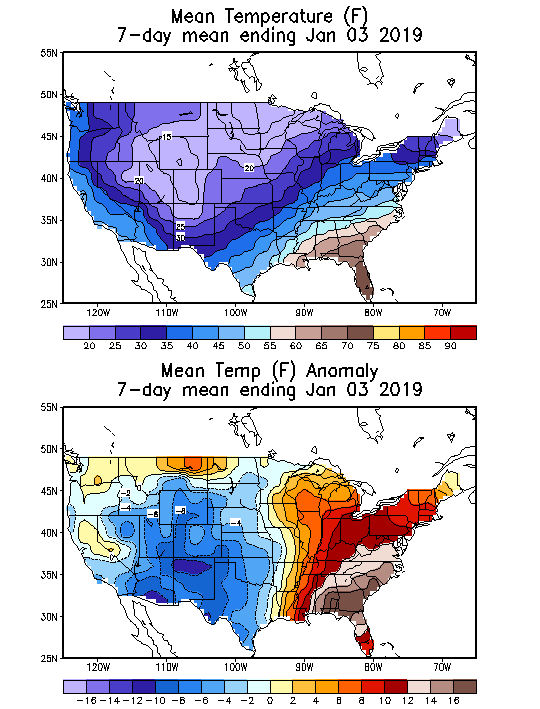
Source: NOAA National Weather Service
Deviation between average and normal (°F)
7-Day Mean ending Jan 03, 2019

Source: NOAA National Weather Service

